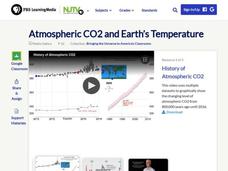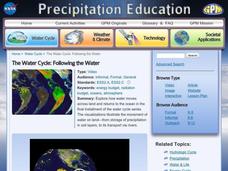TED-Ed
Turbulence: One of the Great Unsolved Mysteries of Physics
While airlines acknowledge turbulence, scientists have yet to solve the mysteries of these air currents. Find out what is known with a short video that explores the complex nature of turbulence.
SciShow
Why Are the Inner and Outer Planets Different?
How did the planets form? An interesting video from the SciShow Space series identifies the differences between the inner and outer planets and how the history of the solar system's sun put everything in its place. Viewers also learn...
SciShow
Why We Send Animals to Space
What were the first living things to travel to space? Long before humans went into orbit, scientists sent animals into space to see how space exploration would affect living things. Viewers of an interesting video learn about how animals...
Be Smart
The Impossible Hugeness of Deep Time
Can we really grasp how old we are? Part of a larger series, the humorous video demonstration shows how humans fit into the history of Earth and just how long ago life formed. Viewers explore a timeline that identifies major markers in...
PBS
Global Winds
Blow budding scientists away with a lesson that'll put wind in their sails! Scholars study the pattern of global winds using an interactive from PBS' Weather and Climate series. Detailed simulations help viewers study upper-level winds...
PBS
The Ocean: A Driving Force for Weather and Climate
What's behind Earth's wild, wonderful, and sometimes weird weather? A lesson from PBS's Weather and Climate series takes viewers on a worldwide trek to examine the many interactions between Earth's atmosphere, oceans, and land masses....
PBS
Atmospheric CO2 and Earth’s Temperature
Is atmospheric carbon dioxide really to blame for global warming? Young environmentalists analyze historical carbon dioxide and temperature data during a multimedia activity from PBS's Weather and Climate series. High schoolers read...
PBS
The Threat to Earth
Is Earth prepared for a massive solar storm? Examine the possibilities with an interesting activity, part of NOVA's Sun Lab interactive unit. Viewers learn about historical solar storms, the tools we have for protecting ourselves and...
PBS
Earth's Magnetic Shield
Our atmosphere is pretty amazing! How does it minimize the effects of solar weather? Scholars discover Earth's first line of defense against the sun—the magnetosphere. The activity, one of several in a sun unit from NOVA, explains how...
NASA
The Water Cycle: Following the Water
Water that leaves the oceans must eventually return. The animations in the final lesson of the four-part NASA series show the complex path water can take across landforms before returning to the ocean. Approximately one-third of the...
NASA
The Water Cycle: Watering the Land
The oceans contribute 37 trillion tons of water to land masses in the form of rain and snow. The third in a four-part series from NASA show satellite animations highlighting the precipitation on Earth. The videos show the movement of the...
Veritasium
An Astronaut's View of Earth
Ever wonder what climate change looks like from above? See Earth's struggle through the eyes of Commander Chris Hadfield with a video from the Veritasium playlist. Commander Hadfield describes his amazing journey through the Southern...
Bozeman Science
ESS2A - Earth Materials and Systems
The water we use today is the same water our ancient ancestors used. A comprehensive video lesson explains this concept and many others as it explores the earth's materials and systems. From the geosphere to the atmosphere, the narrator...
Kurzgesagt – In a Nutshell
Everything You Need to Know About Planet Earth
Earth provides all of the systems needed for life, and how it does that is very complex. The video explains how Earth got here and what makes it special. It details its layers, the atmosphere, and human's place on the planet.
MinuteEarth
Our Atmosphere is Escaping!
Our atmosphere keeps us from the extreme temperatures experienced on the moon. The video explains that our atmosphere actually leaks. It describes exactly which molecules escape and the multiple factors that contribute.
MinutePhysics
Why Isn't The Sky Purple?
We've all heard the tale about why the sky is blue. But, why aren't there stories about why the sky isn't purple? Or indigo? Science scholars explore the properties of visible light in a brief video. The narrator explains polychromatic...
Crash Course
The Earth
Your fingernails grow at approximately the same rate Earth's continents move. The video discusses Earth as a planet, its layers, our magnetic field, the atmosphere, and the human impact on Earth. It provides interesting facts that...
SciShow
Oxygen is Killing You
Prevent cell destruction from free oxygen in your body by eating antioxidants such as blueberries, pecans, cranberries, and dark chocolate. An interesting video discusses the dangerous side of oxygen. From rust to free radicals, viewers...
SciShow
Helium
The helium in a balloon comes from the radioactive decay of the elements thorium and uranium. Video two in this series of 48 explores the element helium. The narrator discusses how humans use it, where it is found, how the United States...
SciShow Kids
Lunar Eclipses
A lunar eclipse or the red moon? This is the focus question of a captivating video hosted by the knowledgable and energetic Jessi and her mouse sidekick Squeaks. Here, the two examine the what, why, and how of lunar eclipses and...
SciShow Kids
Are Aliens Real?
Are aliens real? Find out with an engaging video that details the three ingredients—water, oxygen, and food—necessary for living things to survive.
Be Smart
Whose Air Do You Share?
Take a deep breath before watching this video from PBS Digital Studios that models for viewers how humans are connected through the air we share. The video explores how small the earth's atmosphere is compared to the rest of Earth.
Crash Course
The History of Life on Earth
The first life on Earth developed in the oceans. As an introduction to ecology, the video starts with the formation of the earth. It follows with the Archaean and Proterozoic Eons including protobionts, prokaryotes, and eukaryotes. It...
Crash Course Kids
Severe Weather
What makes severe weather so severe? Very different from regular weather, severe weather is more dangerous and "puts people at risk." This is the focus of a video that explains how severe weather interacts with the biosphere and geosphere.























